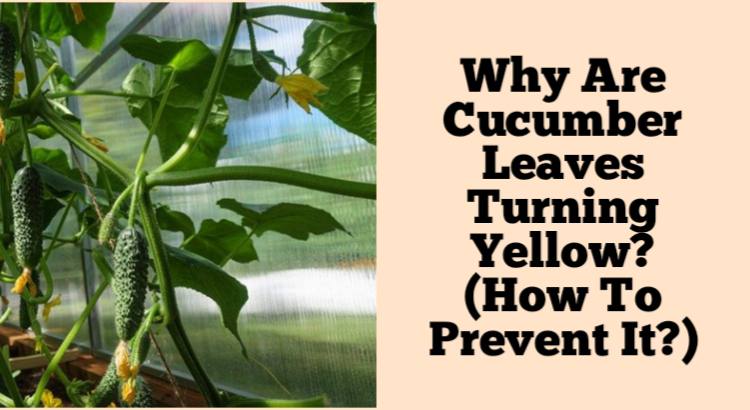Cucumbers are a popular and easy-to-grow vegetable in home gardens, but yellowing leaves on cucumber plants can be a cause for concern for gardeners. Yellowing leaves can be a sign of nutrient deficiencies, pest or disease damage, or environmental stressors.
Why Are My Cucumber Leaves Turning Yellow?
Cucumber plants are a popular choice for home gardeners due to their ease of cultivation and abundance of produce. However, yellowing leaves can be a cause for concern. There are a number of reasons why cucumber leaves may turn yellow, including a lack of nutrients, overwatering or underwatering, pests and diseases, and environmental factors.
One common reason for yellowing leaves is a nitrogen deficiency in the soil. This can be remedied by adding a nitrogen-rich fertilizer to the soil. Another reason could be overwatering or underwatering the plants, which can cause stress and lead to yellowing leaves.
Is Yellowing Of Cucumber Leaves A Sign Of Disease?
Yellowing leaves on cucumber plants can be an indication of disease. The most common diseases that cause yellowing of cucumber leaves include downy mildew, powdery mildew, bacterial wilt, and cucumber mosaic virus.
Downy mildew and powdery mildew are fungal diseases that thrive in humid conditions. Bacterial wilt is caused by a bacterium that is spread by cucumber beetles, and cucumber mosaic virus is spread by aphids. These diseases can cause significant damage to the plant, so it’s important to identify and treat them as soon as possible.
Cucumber Leaves Turning Yellow: Pests Or Insects
There are a number of pests and insects that can cause yellowing of cucumber leaves. Cucumber beetles, spider mites, and aphids are common culprits. Cucumber beetles are small, striped beetles that can carry bacterial wilt disease.
Spider mites are tiny insects that suck the sap from the plant, causing yellowing and a stippled appearance on the leaves. Aphids are small, soft-bodied insects that feed on the sap of the plant, causing the leaves to yellow and distort. Controlling these pests with insecticides or by introducing natural predators like ladybugs can help prevent yellowing of cucumber leaves.
Can Over-Fertilization Cause Yellowing Of Cucumber Leaves?
Over-fertilization can cause yellowing of cucumber leaves. Too much fertilizer can lead to a buildup of salts in the soil, which can damage the roots and cause yellowing of the leaves.
It’s important to follow the recommended guidelines for fertilization and to avoid applying fertilizer when the soil is already moist, as this can lead to burning of the roots. Using a balanced fertilizer and testing the soil regularly can help prevent over-fertilization and yellowing of cucumber leaves.
Can Environmental Factors Like Temperature Or Sunlight Cause Yellowing Of Cucumber Leaves?
Environmental factors like temperature and sunlight can cause yellowing of cucumber leaves. Cucumber plants prefer warm temperatures and will often yellow when exposed to extreme heat or cold.
In addition, cucumber plants require a lot of sunlight to grow, but too much sun exposure can cause the leaves to yellow and dry out. Providing shade and ensuring adequate watering during periods of extreme heat can help prevent yellowing of cucumber leaves.
Cucumber Leaves Turning Yellow: Prevention
Preventing yellowing of cucumber leaves can be achieved by ensuring the plants receive proper care. This includes providing adequate sunlight, watering regularly but not excessively, using a balanced fertilizer, testing the soil regularly, and controlling pests and diseases.
In addition, planting disease-resistant varieties of cucumber can help prevent yellowing of leaves. Providing adequate support for the plants, such as trellising or staking, can also help prevent stress and yellowing.
What Can I Do To Treat Yellowing Cucumber Leaves?
Treatment for yellowing cucumber leaves will depend on the underlying cause. If the yellowing is due to a nutrient deficiency, applying a balanced fertilizer can help.
If the yellowing is due to a disease, identifying and treating the disease with a fungicide or other appropriate treatment can help. If the yellowing is due to pests, controlling the pests with insecticides or natural predators can help prevent further damage.
Are There Any Natural Remedies To Prevent Yellowing Of Cucumber Leaves?
There are several natural remedies that can help prevent yellowing of cucumber leaves. One option is to use companion planting to deter pests and promote healthy growth. For example, planting marigolds near cucumber plants can help deter cucumber beetles.
Another option is to use organic fertilizers, such as compost or manure, which can improve soil health and prevent nutrient deficiencies. Additionally, using natural pest control methods, such as introducing beneficial insects like ladybugs or using neem oil, can help prevent damage from pests and diseases.
How Often Should I Water My Cucumbers To Prevent Yellowing Of Leaves?
Watering cucumber plants regularly but not excessively can help prevent yellowing of leaves. Cucumber plants prefer moist soil, but overwatering can lead to waterlogged roots and yellowing of the leaves.
A good rule of thumb is to water the plants deeply once or twice a week, depending on the climate and soil conditions. It’s important to water the plants at the base, rather than from above, to prevent excess moisture on the leaves, which can promote the growth of fungal diseases. Additionally, watering early in the day can help prevent moisture buildup and reduce the risk of disease.
Should I Remove Yellowing Cucumber Leaves From The Plant?
It is generally recommended to remove yellowing cucumber leaves from the plant. Yellowing leaves can be a sign of disease or pest damage, and removing them can help prevent the spread of the issue.
Additionally, removing yellowing leaves can help improve airflow and light penetration, which can promote healthy growth. However, it’s important to avoid removing too many leaves at once, as this can stress the plant and reduce its ability to produce fruit.


